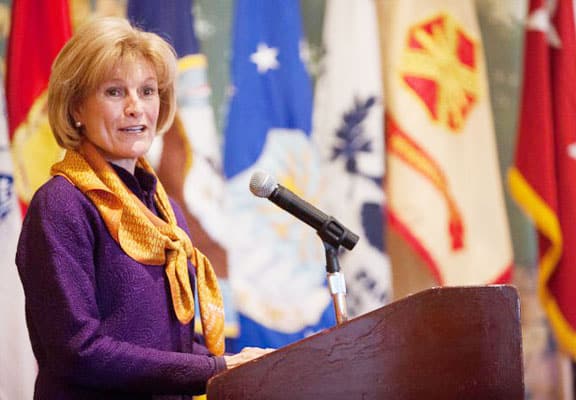

Credit: Courtesy of the U.S. Army
NEW YORK (WOMENSENEWS)–After many years of legislative effort to establish a National Women’s History Museum in the capital, the project notched a major milestone at the tail end of Women’s History Month.
But as it gained steam it also picked up criticism from scholars in an advisory body that recently parted ways with the project.
In a March 25 congressional hearing, two female representatives from both sides of the aisle–Carolyn Maloney, D-N.Y., and Marsha Blackburn, R-Tenn.,–joined Joan Wages, president and CEO of the National Women’s History Museum (NWHM), to express the hope of creating a commission to study the feasibility of establishing the museum, which The New York Times reported would cost $500 million to build.
“We are . . . doing this so that our daughters and our sons and our children for generations to come have the chance to learn the story, the full story, of how this amazing country came to be,” Maloney said during the hearing.
The support of House Majority Leader Eric Cantor, R-Va., means that the bill stands a good chance of coming up for a vote this year now that the project has committed to a private funding basis. Supporters hope to raise the necessary $500 million. So far it has amassed $14 million, according to The New York Times. Congressional approval is needed because museum leaders want to build on federal land.
Denise Baer, executive director and founder of Herstoryhistory, an organization based in Bethesda, Md., dedicated to linking women’s organizations with those who study and interpret women’s history, has raised questions about the sudden dismissal of several women’s history scholars from the project and what she sees as overall flaws in the congressional approval process. She has written an open letter to Congress and President Barack Obama expressing her concerns and she plans to circulate the letter for a couple of months and post it for supporters to sign on the Herstoryhistory website, which is still under construction.
Concerns Raised
Baer supports the establishment of a national museum for women’s history in the capital city, but worries about a group of 18 scholars who formed an advisory council in late 2011 that was dissolved in mid-March.
“We stand with our sisters who – in an affront to their volunteer efforts and their stature as pioneer scholars of women’s history – see their dismissal as politically oriented and as raising questions about the capacity of the NWHM, Inc., to lead what will require a broad public effort based on consensus as well as public and scholarly input,” Baer’s letter says.
Sonya Michel, a professor of history at the University of Maryland, College Park, and one of the scholars, said that seven members of the advisory council had been planning on resigning before their dismissal.
“We kept trying to say . . . that we needed more scholarly input and she just refused to make room for us or to come up with any sort of structured way for us to interact with them,” Michel said in a phone interview, referring to Wages.
The group of seven was in the process of drafting their resignation letter when they received news of the dissolution of the council.
In an email, Wages said the scholars were dismissed simply because the need for their services was still too far in the future.
“As the Scholarly Advisory Councils were created to advise NWHM on the exhibits and programs that would exist in the physical museum, something we now know to be quite a ways off, it was determined that the committees be dissolved,” Wages said in an email interview.
‘Insufficient Public Input’
Baer’s letter criticized the insufficient public input in the congressional bills: “These bills have not been vetted in the women’s community and should be amended prior to coming to the floor.”
Michel agrees, saying: “We were never consulted in the bill and there’s no guarantee that scholars will be involved at all in the planning.”
Wages answers that criticism by pointing to the project’s list of supporters and a planned period of public comment.
“National Women’s History Museum‘s legislation is supported by a national coalition of 52 women’s education, professional and service organizations,” Wages said in the email. “In addition, the bill provides for a public forum to be held to solicit public comment for the commission to consider.”
The scholars’ letter also criticized the quality and sensibility reflected by online exhibits published on the National Women’s History Museum website, the latest of which is titled “Pathways to Equality.” The exhibit was produced in conjunction with Google, the Mountain View, Calif., web giant, and excluded their input. The letter points to problems with “diversity and accuracy” in that exhibit.
“We had not been informed that such an exhibit was in the works, nor were we given an opportunity to review it in advance,” Michel wrote in a letter on March 24 to members of the House Committee on Natural Resources, Subcommittee on Public Lands and Environmental Regulation. “Upon viewing the exhibit, we discovered to our dismay that it was not only poorly written and difficult to follow, but also riddled with historical errors and inaccuracies.”
Wages says the museum has a proven “commitment to diversity” borne out by several other exhibits and that guest scholars can speak to these issues.
Reem Zubaidi is an intern for Women’s eNews. She is a third year student studying journalism at Northwestern University in Qatar.
Would you like to Comment but not sure how? Visit our help page at https://womensenews.org/help-making-comments-womens-enews-stories.
Would you like to Send Along a Link of This Story? https://womensenews.org/story/our-history/140327/womens-history-museum-picks-steam-controversy

